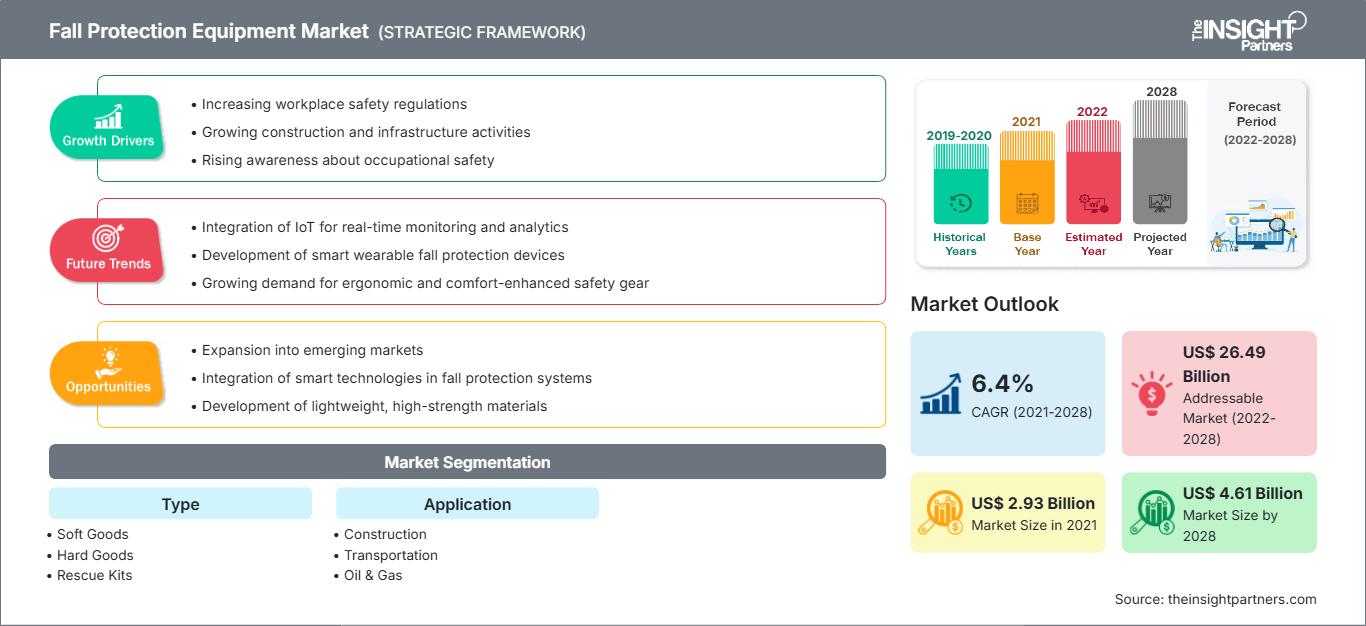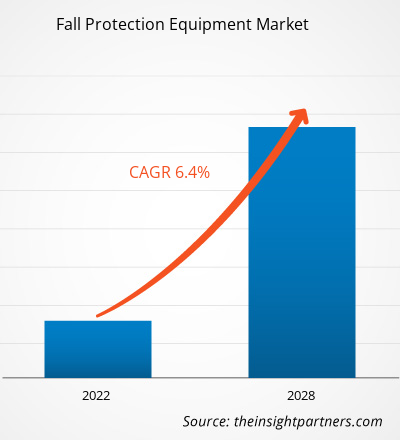Le marché des équipements de protection antichute devrait passer de 2 934,86 millions de dollars américains en 2021 à 4 606,61 millions de dollars américains d'ici 2028 ; sa croissance devrait atteindre un TCAC de 6,4 % entre 2021 et 2028.
L'industrialisation rapide des pays développés et en développement est l'un des principaux facteurs de l'expansion du marché. Les risques professionnels sont de plus en plus fréquents en raison de l'absence de procédures de sécurité adéquates sur divers sites de fabrication, d'exploitation minière et autres sites industriels. Comparé à d'autres pays, les États-Unis sont plus soucieux de la sécurité et de la santé de leurs travailleurs, ce qui favorise l'adoption d'équipements de protection antichute dans le pays. Pour superviser les normes et procédures de sécurité, le pays a mis en place certaines autorités telles que l'Occupational Safety and Health Administration (OSHA) et l'American National Standards Institute (ANSI). L'OSHA est un organisme de réglementation et de conformité en matière de santé et de sécurité qui dispense aux travailleurs des formations de sensibilisation de 10 et 30 heures sur les réglementations et normes OSHA applicables à divers métiers du travail. Cependant, l'attention croissante portée aux pratiques de sécurité au travail et l'amélioration des réglementations gouvernementales en matière de sécurité des travailleurs en Europe et en Asie ont stimulé le marché. L'essor des activités de construction et la croissance du secteur pétrolier et gazier dans les pays asiatiques comme l'Inde et la Chine, en raison de la croissance démographique, devraient soutenir la croissance du marché au cours de la période de prévision. L'urbanisation croissante et la croissance du secteur pétrolier et gazier comptent parmi les principaux facteurs de croissance du marché des équipements de protection antichute dans les régions Moyen-Orient et Afrique (MOA) et Amérique du Sud (SAM).
Vous bénéficierez d’une personnalisation sur n’importe quel rapport - gratuitement - y compris des parties de ce rapport, ou une analyse au niveau du pays, un pack de données Excel, ainsi que de profiter d’offres exceptionnelles et de réductions pour les start-ups et les universités
Marché des équipements de protection antichute: Perspectives stratégiques

- Obtenez les principales tendances clés du marché de ce rapport.Cet échantillon GRATUIT comprendra une analyse de données, allant des tendances du marché aux estimations et prévisions.
L'épidémie de COVID-19 a continué de faire sentir ses effets néfastes dans plusieurs pays en 2021. Les fermetures d'usines de production ou les activités commerciales limitées, ainsi que les confinements et les restrictions de voyage, ont entravé la production et la chaîne d'approvisionnement d'équipements de protection antichute. La demande constante d'équipements de protection antichute a connu une légère baisse en 2020, en raison du confinement imposé par le gouvernement et du faible nombre de projets de construction. Cependant, en 2021, en raison de l'augmentation des activités de construction, de l'exploration pétrolière et gazière et des projets de télécommunications, il existe une demande d'équipements de protection antichute pour assurer la sécurité des employés. Le commerce électronique a également contribué à accroître la demande d'équipements de protection antichute dans le secteur de la construction.
Aperçu du marché des équipements de protection antichute : hausse des activités de construction
L'augmentation des activités de construction dans le monde est un élément essentiel du marché des équipements de protection antichute. Alors que les pays asiatiques comme l'Inde et la Chine connaissent une croissance démographique importante, la demande d'espaces commerciaux et résidentiels y est en constante augmentation. L'économie mondiale connaît actuellement un ralentissement important en raison d'une contrainte de crédit croissante, qui empêche les économies du monde entier d'atteindre leurs ambitions de développement. Les infrastructures restent une priorité majeure pour combler les écarts de développement dans le contexte actuel, car elles sont considérées comme omnipotentes et capables de sortir les économies de la crise financière. Les gouvernements du monde entier investissent dans les infrastructures physiques et sociales afin d'accroître la demande de produits et de services en créant des emplois.
Analyses du marché par type
Le marché des équipements de protection antichute est segmenté en fonction du type : produits souples, produits durables, kits de sauvetage, ceintures de sécurité, harnais de sécurité complets, etc. Le segment des produits durables est le segment leader car il offre une sécurité renforcée. De plus, l'innovation croissante dans ce segment devrait stimuler la croissance du marché. Cependant, la demande croissante de harnais de sécurité complets de la part de tous les utilisateurs industriels contribue à la croissance du segment au TCAC le plus élevé.
Aperçu du marché basé sur les applications
En termes d'application, le marché des équipements de protection antichute est divisé en secteurs : la construction, le pétrole et le gaz, les transports, l'énergie et les services publics, et les télécommunications. Pour assurer le bon déroulement des activités et maintenir la sécurité des travailleurs, chaque secteur a besoin d'équipements de protection antichute dans ses installations. En 2020, le secteur de la construction représentait la plus grande part de marché.
Les acteurs du marché des équipements de protection antichute adoptent des stratégies telles que les fusions, les acquisitions et les initiatives commerciales pour maintenir leurs positions. Voici quelques développements des principaux acteurs :
- En mai 2021, Pure Safety Group a regroupé sa famille de marques de sécurité en hauteur — Stronghold by PSG, Ty-Flt, Checkmate et HART — sous la bannière Guardian. Cette expansion a désormais fait de Guardian la plus grande marque indépendante de protection et de prévention des chutes au monde.
- 3M Fall Protection a inventé et inclus des sangles de sécurité contre les traumatismes de suspension sur tous les harnais 3M DBI SALA certifiés ANSI et CSA d'ici fin mars 2021.
Marché des équipements de protection antichute
Les tendances et facteurs régionaux influençant le marché des équipements de protection antichute tout au long de la période de prévision ont été analysés en détail par les analystes de The Insight Partners. Cette section aborde également les segments et la répartition géographique du marché des équipements de protection antichute en Amérique du Nord, en Europe, en Asie-Pacifique, au Moyen-Orient et en Afrique, ainsi qu'en Amérique du Sud et en Amérique centrale.
Portée du rapport sur le marché des équipements de protection antichute| Attribut de rapport | Détails |
|---|---|
| Taille du marché en 2021 | US$ 2.93 Billion |
| Taille du marché par 2028 | US$ 4.61 Billion |
| TCAC mondial (2021 - 2028) | 6.4% |
| Données historiques | 2019-2020 |
| Période de prévision | 2022-2028 |
| Segments couverts |
By Type
|
| Régions et pays couverts | Amérique du Nord
|
| Leaders du marché et profils d'entreprises clés |
|
Densité des acteurs du marché des équipements de protection antichute : comprendre son impact sur la dynamique des entreprises
Le marché des équipements de protection antichute connaît une croissance rapide, portée par une demande croissante des utilisateurs finaux, due à des facteurs tels que l'évolution des préférences des consommateurs, les avancées technologiques et une meilleure connaissance des avantages des produits. Face à cette demande croissante, les entreprises élargissent leur offre, innovent pour répondre aux besoins des consommateurs et capitalisent sur les nouvelles tendances, ce qui alimente la croissance du marché.
- Obtenez le Marché des équipements de protection antichute Aperçu des principaux acteurs clés
- Biens souples
- Biens durables
- Kits de sauvetage
- Ceintures de sécurité
- Harnais de sécurité complet
- Autres
Par application
- Construction
- Transport
- Pétrole et gaz
- Exploitation minière
- Énergie et services publics
- Télécommunications
- Autres
Par zone géographique
Nord Amérique
- États-Unis
- Canada
- Mexique
Europe
- France
- Allemagne
- Italie
- Royaume-Uni
- Russie
- Reste de l'Europe
Asie-Pacifique (APAC)
- Chine
- Inde
- Corée du Sud
- Japon
- Australie
- Reste de l'APAC
Moyen-Orient et Afrique (MOA)
- Afrique du Sud
- Arabie saoudite
- Émirats arabes unis
- Reste de la MOA
Amérique du Sud (SAM)
- Brésil
- Argentine
- Reste de la SAM
Profils d'entreprise
- 3M
- Falltech
- French Creek Production
- Frontline
- Guardian Fall Protection
- Kee Safety
- KwikSafety
- MSA Safety Incorporated
- Honeywell International Inc.
- Tritech Fall Protection
- Analyse historique (2 ans), année de base, prévision (7 ans) avec TCAC
- Analyse PEST et SWOT
- Taille du marché Valeur / Volume - Mondial, Régional, Pays
- Industrie et paysage concurrentiel
- Ensemble de données Excel
Rapports récents
Témoignages
Raison d'acheter
- Prise de décision éclairée
- Compréhension de la dynamique du marché
- Analyse concurrentielle
- Connaissances clients
- Prévisions de marché
- Atténuation des risques
- Planification stratégique
- Justification des investissements
- Identification des marchés émergents
- Amélioration des stratégies marketing
- Amélioration de l'efficacité opérationnelle
- Alignement sur les tendances réglementaires




















 Obtenez un échantillon gratuit pour - Marché des équipements de protection antichute
Obtenez un échantillon gratuit pour - Marché des équipements de protection antichute